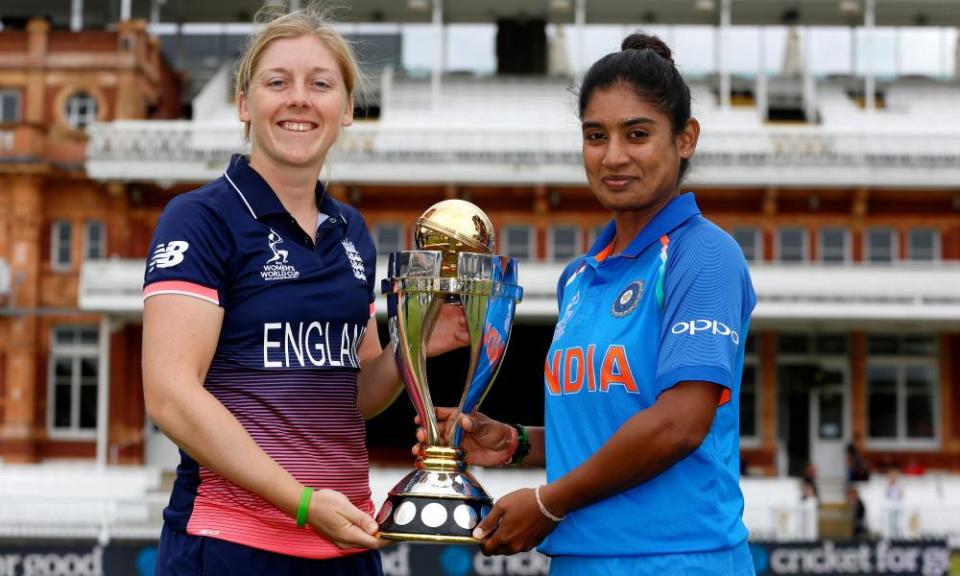Women’s World Cup 2017: England fully prepared for destructive India

Both captains entered the Lord’s museum with beaming smiles that broke for a moment as they cast their eyes on the trophy to their left before taking their seats to address the media. Of all the collections in all the cricket grounds, this is one that rarely struggles for attention. Before a momentous Women’s World Cup final between England and India, the trinkets at the Home of Cricket played second fiddle.
India’s captain, Mithali Raj, arrived first, calm and composed before her final World Cup match. There is not much in the game she has not witnessed in an international career that started in England in 1999 and has seen her amass 228 international caps. Contrast that to England captain Heather Knight, whose 74 ODI appearances at 26 years of age hints at a precocious talent that came good when in fact she is only just getting started. Both have young sides at their disposal.
Raj knows hers will not be overawed, even if they did want to take a few pictures of their historic surroundings. Knight revealed their Saturday evening would be spent watching Love Island. Whatever the choice of extra-curricular activity, the brunt of the homework was done on Friday.
Both sides say there is little they can take from the opening match of the tournament, in which India beat England in Derby by 35 runs. Time has passed, personnel have changed and so have their collective merits.
For example, India, tentative in the group stages, were a different beast against Australia in their semi-final, where they managed to post 281 for four from a reduced 42 overs. Harmanpreet Kaur’s unbeaten 171 was devastating and did not go unnoticed. “What an innings that was,” exclaimed Knight, when asked if she caught the knock of the tournament.
England know what sort of player she is and have taken the time to look through her merry destruction of Australia’s spinners in particular and see how they could have done better. One of the elements they picked up on was how the likes of Jess Jonassen, a usually calm left-arm spinner who had not gone for more than six runs an over before Kaur’s tornado blew her away for nine a pop, did not change her line of attack to the right-hander. At no point did she try to cramp her for room from around the wicket.
This is where England’s own southpaw turner Alex Hartley comes into play. The majority of her overs – and she’s bowled the most for England this World Cup – have been to right-handers from around the wicket. Teams have struggled to get her away, such is the effectiveness of a round-arm action and a short trajectory giving her the dip and turn needed to challenge a batsman on both line and length.
As much as it has been England’s batting that has grabbed the headlines – they boast the highest run rate of any side, three players with more than 350 runs in the competition (Tammy Beaumont, Knight and Sarah Taylor) and six hundreds split between five players (no other side has more) – it has been their ability to contain sides with the ball that has got them out of tight situations against Australia and South Africa in the semi-final.
Whether it is Hartley, off-spinner Laura Marsh, the quicker bowlers in Katherine Brunt, Anya Shrubsole and Jenny Gunn, or even Knight herself, she has seen enough from her attack to know it can cope with whatever Kaur, or any other Indian batsmen, sends their way. “We’ve got our plans to her [Kaur]. They’ve got a number of players who’ve done well. If they do get in, it’s about our bowlers being smart. You’ve seen in the tournament, the bowlers have got a lot smarter and bowled on some good pitches and on slow wickets so I think our bowlers have got the skills to adapt to the wicket and what their batter’s doing at the other end.”
While Raj knows her side has the edge in terms of wicket-takers (only Australia have taken more than India’s 66 wickets), she admits that her side have discussed how best to knock England’s bowlers out of their groove.
“If you see the last two games against New Zealand and Australia the batters have come good. We will have a few plans up our sleeves, it all comes down to how we will implement them and how we perform tomorrow.”
There is, of course, that great intangible: pressure.
The stands will be packed and the support full on for both sides, especially with India’s Bharat Army, armed with percussion, looking to reproduce the atmosphere they created during India men’s ICC Champions Trophy run. Not to mention the chance to lift the World Cup for two sides who have undergone 18-months of introspection and graft.
Lord’s, too, will provide its own weight on their shoulders. Such is the state of women’s cricket that this World Cup final will be the first match some of the English players will have played at this ground. Conversely, a few Indian players, including Raj, have experience here.
But Sunday is not about Lord’s. An England win could kickstart a new generation of players in this country. Success for India could see funding go through the roof as the BCCI look to build on its success with initiatives such as a women’s IPL. Regardless of what Raj has done and what Knight will do, this 2017 World Cup final is the most important match of their careers.

 Yahoo Movies
Yahoo Movies 